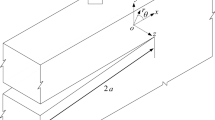Abstract
Thick three-dimensional (3-D) finite element models of centre cracked plates are used to study the variation in the biaxiality factor β with the crack aspect ratio a/w. The use of two widely accepted methods to evaluate the T-stress in two-dimensions, namely the boundary layer method and the displacement field method, to calculate the T-stress in three-dimensions is studied. It is shown that the boundary layer method gives results that compare rather well with the two-dimensional plane strain values (maximum difference of 6 percent), while the displacement field method results are about 15 percent lower. Two parameters are shown to affect the three-dimensional evaluation of the biaxiality factor, namely the material's Poisson's ratio ν and the specimen's thickness t. The biaxiality factor is directly proportional to ν and inversely proportional to t. Three-dimensional analysis is required to assess correctly the effect of ν and t on β.
Similar content being viewed by others
References
M.LWilliams, Journal of Applied Mechanics 24 (1957) 111–114.
J.R.Rice, Journal of the Mechanics and Physics of Solids 22 (1974) 17–26.
S.G.Larsson and A.J.Carlsson, Journal of the Mechanics and Physics of Solids 21 (1973) 263–278.
P.S.Leevers and J.C.Radon, International Journal of Fracture 19 (1982) 311–325.
A.M.Al-Ani and J.W.Hancock, Journal of the Mechanics and Physics of Solids 39 (1991) 23–43.
E.Sommer and D.Aurich, in Defect Assessment in Components — Fundamentals and Applications, ESIS/EGF9, J.G.Blauel and K.-H.Schwalbe (eds.), Mechanical Engineering Publications, London (1991) 141–174.
ANSYS User's Manual, version 4, Swanson Analysis Systems, Inc. (1988).
ABAQUS User's Manual, version 4-9-1, Hibbitt, Karlsson and Sorensen, Inc., Providence, RI (1993).
Y.-Y. Wang and D.M. Parks, International Journal of Fracture (1992) 25–40.
A.P.Kfouri, International Journal of Fracture 30 (1986) 301–315.
T.-L.Sham, International Journal of Fracture 48 (1991) 81–102.
T.Nakamura and D.M.Parks, International Journal of Solids and Structures 29 (1992) 1597–1611.
B.A.Bilby, G.E.Cardew, M.R.Goldthrope and I.C.Howard, in Size Effects in Fracture, Mechanical Engineering Publications Limited, London (1986) 37–46.
B. Gray, M.M.K. Lee and A.R. Luxmoore, ‘A Numerical Investigation of the J-T Approach for Homogeneous CCT and 3PB Specimens’, Internal Report, Department of Civil Engineering, University College of Swansea, January 1994.
Z.Yongyuan and R.Guohua, Engineering Fracture Mechanics 47 (1994) 317–325.
G.C.Sih and Y.D.Lee, Theoretical and Applied Fracture Mechanics 12 (1989) 1–17.
D.M.Parks, in Defect Assessment in Components — Fundamentals and Applications, ESIS/EGF9, J.G.Blauel and K.-H.Schwalbe (eds.), Mechanical Engineering Publications, London (1991) 205–231.
C.F.Shih, N.P.O'Dowd and M.T.Kirk, in Defect Assessment in Components — Fundamentals and Applications, ESIS/EGF9, J.G.Blauel and K.-H.Schwalbe (eds.), Mechanical Engineering Publications, London (1991) 2–20.
Author information
Authors and Affiliations
Rights and permissions
About this article
Cite this article
Henry, B.S., Luxmoore, A.R. Three-dimensional evaluation of the T-stress in centre cracked plates. Int J Fract 70, 35–50 (1994). https://doi.org/10.1007/BF00018134
Received:
Accepted:
Issue Date:
DOI: https://doi.org/10.1007/BF00018134




